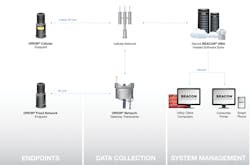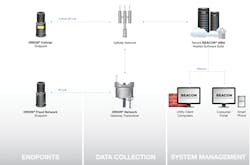Four Key Metering Trends to Help Water Utilities Get 'Smarter' in '16
by Kristie Anderson
Looking back on 2015, severe droughts, flat budgets and insights on decreased reading system life have all affected the way water utility managers make decisions about metering systems. As utilities plan for 2016, managers should consider four key water metering technology trends predicted to help utilities meet their water management initiatives in 2016 and beyond.
1. Future-Proof Cellular Technology: A 2015 sponsored study completed by industry expert Dr. Howard Scott, PhD, revealed that water utilities change their AMR/AMI meter reading systems at an average age of 8.2 years - far more frequently than the equipment’s 20-year life expectancy. As meter reading communications technology and analytics systems have rapidly evolved (and continue to do so), it makes sense that water utilities have been changing their systems to keep pace with advancing technology as well as operational and customer needs. However, when a utility budgets for an upgrade every 20 years, being forced to update more frequently presses already stretched budgets even further.
Enter a new appreciation for the cellular-enabled smart meter. Cellular metering technology frees utilities from owning and maintaining their own infrastructure, and allows them to benefit from consistent updates. Cellular technology also allows for utilities to benefit from continual updates that improve the performance and functionality of endpoint and gateway technology. In 2016, more utilities are expected to upgrade to cellular as it reduces these expenses and allows utilities to do more with existing resources.
2. Managed Solution Model: As adoption of cellular and fixed network technology continues to increase in 2016, utilities will also see an increase in the use of the managed solution model. One of its key components is the use of web-based software services or cloud computing. Quick to deploy with no hardware to purchase, cloud software is owned, maintained and installed by an outside vendor; however, the data remains the property of the utility. Because software is “hosted” by the solutions vendor, staff requirements related to infrastructure and software are reduced and municipalities have more time to focus on their core competency of operating their utility and serving their customers. Hosting software and data off-site in secure data centers also leaves critical metering data less susceptible to natural disasters and power outages.
In a managed solution, a network analysis of the deployment area is performed to determine the optimal mix of technologies to achieve system performance goals. Should the analysis recommend the inclusion of any fixed network gateways and endpoints, the solutions vendor will take care of the installation and maintenance, again leaving time for the utility to do what it does best.
Additionally, managed solutions are typically paid for through a monthly fee per endpoint that includes the software suite with regular updates, fixed network and/or cellular endpoints and long-term support and maintenance. This model of payment will make managed solutions a fiscally feasible option for utilities in 2016.
3. Rise of Big Data: The continued growth of smart meters in 2015 brought the issue of “big data” to the forefront for many utilities. This growth trend is expected to continue in 2016, with both utilities and consumers seeking out systems that allow them to better understand and use the vast amount of information provided to them by their metering systems.
For utilities, more information should not mean more work, and the most effective metering software solutions will provide utilities with analytics that promote action. Customizable dashboards that allow utility managers to prioritize the information that’s most relevant to their utility will become more important in 2016 as utilities seek to further maximize the efficiency of their systems and reduce consumption.
One of the easiest ways to reduce consumption with the application of data is through leak detection. Near real-time water consumption data supplied by the meter reading system will show sharp, unexplained spikes in usage if a leak is present. With this information, utilities can locate and repair the leak, saving both money and water. Leak detection is especially important in states like California that are looking for every possible way to conserve water. Finding and stopping leaks represents a low-hanging fruit in reducing consumption.
For consumers, too, droughts and water shortages throughout significant areas of the United States have created a need to become more mindful of water consumption. The increased amount of information available to utilities through smart meters can be shared with customers in an understandable way through applications that allow them to view and understand their water usage. Access to meter reading data can promote behavior changes that increase conservation and allow consumers to see firsthand the results of their efforts in real time.
Because the utility and the consumer have access to water usage data, consumer applications can also reduce the time utilities must spend resolving billing disputes.
4. Smart City Movement: According to the United Nations, about 54 percent of the world’s population currently lives in urban areas and this number will increase to about 6.3 billion - 66 percent of the world’s population - by 2050. Rapid urbanization brings many challenges to city planners and leaders. Chief among them is how cities will meet the escalating demands of current residents while simultaneously planning for the needs of future residents. The smart city movement aims to increase sustainability by integrating information, communications and technology across areas of a city.
The smart grid concept started with electric utilities and evolved to include natural gas. Smart water networks are still in their infancy - but growing. Organizations like the Smart Cities Council, a coalition of industry thought leaders, innovators and practitioners, continue to push for the development of smart water networks, smart grids and other developments in the energy sector to help improve the livability, workability and sustainability of the world’s cities. With increased visibility from cloud technology, city planners can make informed decisions about resources that will lead to long-term fiscal savings and ecological gains.
As technology advances, it will become more accessible to utilities and municipalities, especially from a fiscal standpoint. In 2016, creators will continue the trend of developing technology that enhances quality of life as utilities look to make positive environmental and social impacts. These two goals will intersect to further the momentum of the smart city movement.
About the Author: Kristie Anderson has over 20 years of experience in marketing and product management, with extensive expertise in adapting new technology to maximize customer value. In her current role as product marketing manager for Badger Meter, she is responsible for the BEACON® Advanced Metering Analytics managed solution. She holds degrees in marketing management and business administration from the School of Business at the University of Wisconsin-Madison.
More WaterWorld Current Issue Articles
More WaterWorld Archives Issue Articles


